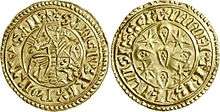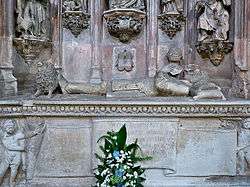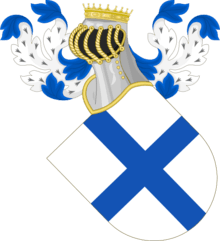Sancho I of Portugal
| Sancho I | |
|---|---|
.png) | |
| King of Portugal | |
| Reign | 6 December 1185 – 26 March 1212 |
| Coronation | 9 December 1185 |
| Predecessor | Afonso I |
| Successor | Afonso II |
| Born |
11 November 1154 Coimbra, Kingdom of Portugal |
| Died |
26 March 1211 (aged 56) Coimbra, Kingdom of Portugal |
| Burial | Santa Cruz Monastery, Coimbra |
| Spouse | Dulce of Aragon |
| Issue Among others... |
Theresa, Queen of León Sancha, Lady of Alenquer Afonso II Peter I, Count of Urgell Ferdinand, Count of Flanders Mafalda, Queen of Castile Infanta Branca, Lady of Guadalajara Berengaria, Queen of Denmark |
| House | Burgundy |
| Father | Afonso I of Portugal |
| Mother | Maud of Savoy |
| Religion | Roman Catholic |
Sancho I (Portuguese pronunciation: [ˈsɐ̃ʃu]), nicknamed "the Populator" (Portuguese: "o Povoador"), King of Portugal (Coimbra, 11 November 1154[1] – 26 March 1211[2][3]) was the second but only surviving legitimate son and fifth child of Afonso I of Portugal by his wife, Maud of Savoy. Sancho succeeded his father and was crowned in Coimbra when he was 31 years old on 9 December 1185.[4] He used the title King of Silves from 1189 until he lost the territory to Almohad control in 1191.[5]
Early life
Sancho was baptized with the name Martin (Martinho) since he was born on the feast day of Saint Martin of Tours.[6][7] On 15 August 1170, he was knighted by his father, King Afonso I,[8] and from then on he became his second in command, both administratively and militarily. At this time, the independence of Portugal (declared in 1139) was not firmly established. The kings of León and Castile were trying to re-annex the country and the Roman Catholic Church was late in giving its blessing and approval. Due to this situation Afonso I had to search for allies within the Iberian Peninsula. Portugal made an alliance with the Crown of Aragon and together they fought Castile and León. To secure the agreement, Sancho married Dulce,[9][10] younger sister of King Alfonso II of Aragon, in 1174. Aragon was thus the first Iberian kingdom to recognize the independence of Portugal.
Succession
With the death of Afonso I in 1185, Sancho I became the second king of Portugal. Coimbra was the centre of his kingdom; Sancho terminated the exhausting and generally pointless wars against his neighbours for control of the Galician borderlands. Instead, he turned all his attentions to the south, towards the Moorish small kingdoms (called taifas) that still thrived. With Crusader help he took Silves in 1188.[11] Silves was an important city of the South, an administrative and commercial town with population estimates around 20,000 people. Sancho ordered the fortification of the city and built a castle which is today an important monument of Portuguese heritage. However, military attention soon had to be turned again to the North, where León and Castile threatened again the Portuguese borders. Silves was again lost to the Moors in 1191.[12]
Legacy

Sancho I dedicated much of his reign to political and administrative organization of the new kingdom. He accumulated a national treasure, supported new industries and the middle class of merchants. Moreover, he created several new towns and villages (like Guarda in 1199[13]) and took great care in populating remote areas in the northern Christian regions of Portugal – hence the nickname "the Populator".[14] The king was also known for his love of knowledge and literature. Sancho I wrote several books of poems and used the royal treasure to send Portuguese students to European universities. He died in Coimbra, aged 56.
Marriage and issue
Sancho married Dulce, daughter of Raymond Berenguer IV, Count of Barcelona, and Petronilla, Queen of Aragon. Eleven children were born from her marriage to King Sancho, nine of whom reached adulthood:

- Theresa (1175/1176 – 18 June 1250),[15][16] she became the wife of King Alfonso IX of León and was beatified in 1705;
- Sancha (1180 – 13 March 1229),[17], founded the Monastery of Celas near Coimbra where she lived until her death. Her sister Theresa arranged for her burial at the Monastery of Lorvão. She was beatified by Pope Clement XI in 1705, the same year as Theresa;[18]
- Constanza (May 1182 – 3 August 1202). She must have died before 1186 since her name is not registered in any of the documents of the chancellery of Sancho I which begins in that year";[16] [lower-alpha 1]
- Afonso (23 April 1186[19] – 25 March 1223), succeeded his father as the third king of Portugal;
- Raymond (1187/88 – 9 March bef. 1188/89), who died in infancy;[19][lower-alpha 2]
- Peter (23 February 1187[19] – 2 June 1258), spouse of Aurembiaix, countess of Urgell;
- Ferdinand (24 March 1188[19] – 27 July 1233), count through his marriage to Joan, Countess of Flanders;
- Henry (aft. March 1189 – 8 Dec aft. 1189), who died during infancy;[19][lower-alpha 3]
- Mafalda (1195/1196[19] – 1 May 1256), the wife of Henry I of Castile, was beatified in 1793;
- Branca (1198 – 17 November 1240), probably the twin sister of Berengaria,[19] was raised in the court with her father and his mistress "a Ribeirinha" and, when she was eight or ten years old, was sent to live with her sisters at the Monastery of Lorvão. She was a nun at a convent in Guadalajara and was buried at the same monastery as her mother;[20]
- Berengaria (1198 – 27 March 1221), probably the twin sister of Branca,[19] married Valdemar II of Denmark in 1214.[21]
Children out of wedlock
With Maria Aires de Fornelos, daughter of Aires Nunes de Fornelos and Maior Pais, who was buried at the Monastery of Santo Tirso in accordance with her last will, Sancho had two children, both born before his marriage to Dulce of Aragon:[22][23][lower-alpha 4]
- Martim Sanches (born before 1175)[25][23] Count of Trastámara. Martim married Elo Pérez de Castro, with no issue from this marriage;[26]
- Urraca Sanches[16] (born before 1175),[27][26] was married to Lourenço Soares, son of Soeiro Viegas and Sancha Bermúdez de Traba.
After Dulce's death, he had an affair with María Pais de Ribeira "a Ribeiriña" for whom he wrote and dedicated a cantiga de amigo, A Ribeirinha, composed in 1199, the oldest text known in Portuguese poetry.[23] At least six children were born of this relationship:[28][29]
- Rodrigo Sanches (died 1245), had a bastard son with Constança Afonso de Cambra called Afonso Rodrigues, a Franciscan friar and the "Guardian of the Convent of Lisbon";[26][30]
- Gil Sanches (died on 14 September 1236), a cleric and troubadour, his father left him 8,000 morabetinos in his will. Gil granted fueros to the settlers of Sardezas in 1213;[26][31]
- Nuno Sanches, he died in his childhood on a 16 of December in an unknown year. He could also have been the son of Maria Aires de Fornelos;[32]
- Maior Sanches, also died at an early age on 27 of August of an unknown year;[33]
- Teresa Sanches, her father left her 7,000 morabetinos in his will. She was the second wife of Alfonso Téllez de Meneses whom she married before 1220 and with whom she had issue;[26]
- Constança Sanches (1204-8 August 1269). Her father left her 7,000 morabetinos in his will. She was the God-mother of her grand-niece, Infanta Sancha and left her half of Vila do Conde, Avelaneda, Pousadela, Parada and Maçãs. She also owned estates in Torres Vedras.[34]
King Sancho also had one son with Maria Moniz de Ribeira, daughter of Munio Osorio, tenente of the comarca of Cabreira and Ribera,and of Maria Nunes of Grijó,[35]:
- Pedro Moniz, who married a woman whose name is not recorded, and was the father of Maria Peres de Cabreira, the wife of Martim Peres Machado, the first to use the last name Machado.[36]
Ancestors
| Ancestors of Sancho I of Portugal | |||||||||||||||||||||||||||||||||||||||||||||||||||||||||||||||||||||||||||||||||||||||||||||||||||||||||||||||||||||||||||||||||||||||||||||||||||||||||||||||||||||||||||||||||||||||||||||||||||||||||||||||||||||||||||||||||||||||||||||||||||||||||||||||||||||||||||||||||||||||||||||||||||||||||||||||||||||||||||||||||||||||||||||||||||||||||||||||||||||||||||||||||||||||||||||||||||||||||||||||||||||||||||||||||||||||||||||||
|---|---|---|---|---|---|---|---|---|---|---|---|---|---|---|---|---|---|---|---|---|---|---|---|---|---|---|---|---|---|---|---|---|---|---|---|---|---|---|---|---|---|---|---|---|---|---|---|---|---|---|---|---|---|---|---|---|---|---|---|---|---|---|---|---|---|---|---|---|---|---|---|---|---|---|---|---|---|---|---|---|---|---|---|---|---|---|---|---|---|---|---|---|---|---|---|---|---|---|---|---|---|---|---|---|---|---|---|---|---|---|---|---|---|---|---|---|---|---|---|---|---|---|---|---|---|---|---|---|---|---|---|---|---|---|---|---|---|---|---|---|---|---|---|---|---|---|---|---|---|---|---|---|---|---|---|---|---|---|---|---|---|---|---|---|---|---|---|---|---|---|---|---|---|---|---|---|---|---|---|---|---|---|---|---|---|---|---|---|---|---|---|---|---|---|---|---|---|---|---|---|---|---|---|---|---|---|---|---|---|---|---|---|---|---|---|---|---|---|---|---|---|---|---|---|---|---|---|---|---|---|---|---|---|---|---|---|---|---|---|---|---|---|---|---|---|---|---|---|---|---|---|---|---|---|---|---|---|---|---|---|---|---|---|---|---|---|---|---|---|---|---|---|---|---|---|---|---|---|---|---|---|---|---|---|---|---|---|---|---|---|---|---|---|---|---|---|---|---|---|---|---|---|---|---|---|---|---|---|---|---|---|---|---|---|---|---|---|---|---|---|---|---|---|---|---|---|---|---|---|---|---|---|---|---|---|---|---|---|---|---|---|---|---|---|---|---|---|---|---|---|---|---|---|---|---|---|---|---|---|---|---|---|---|---|---|---|---|---|---|---|---|---|---|---|---|---|---|---|---|---|---|---|---|---|---|---|---|---|---|---|---|---|---|---|---|---|---|---|---|---|---|---|---|---|---|---|---|---|---|---|---|---|---|---|---|---|---|---|---|---|---|---|---|---|---|---|---|---|---|---|---|
| |||||||||||||||||||||||||||||||||||||||||||||||||||||||||||||||||||||||||||||||||||||||||||||||||||||||||||||||||||||||||||||||||||||||||||||||||||||||||||||||||||||||||||||||||||||||||||||||||||||||||||||||||||||||||||||||||||||||||||||||||||||||||||||||||||||||||||||||||||||||||||||||||||||||||||||||||||||||||||||||||||||||||||||||||||||||||||||||||||||||||||||||||||||||||||||||||||||||||||||||||||||||||||||||||||||||||||||||
Notes
- ↑ However, the necrology of São Salvador de Moreira records the death “III Non Aug” in 1202 of “Domna Constantia Infantula filia regis domni Sancii et reginæ domnæ Dulciæ”. A. C. de Sousa: Historia Genealogica da Casa Real Portugueza Lisbon 1735, vol. I, p. 88 (no source citation reference).
- ↑ The necrology of Santa Cruz de Coimbra records the death “VII Id Mar” of “dominus Raimundus filius domini regis Sancii et reginæ donnæ Dulciæ”; A. Brandaõ: Quarta Parte da Monarchia Lusitana, Lisbon 1632, Liber XII cap. XXI, p. 33. He was presumably not alive in Mar 1189, the date of his father´s charter in which he is not named. It's probable that Raymond wasn't his parents´ oldest son as naming the first son after his maternal grandfather was unusual. If that is correct, the known dates of birth of his siblings indicate that Raimundo was born either in 1186 or after 1189.
- ↑ The Nobiliario of Pedro Conde de Barcelos names "D. Alonso Sanchez, El Infante D. Pedro, El Infante D. Fernando Conde de Flandes, El Infante D. Enrique" as the sons of "D. Sancho Rey de Portugal" and his wife "D. Aldonça"; Pedro Barcelos, Tit. VII, Reyes de Portugal, 3 p. 30. He was presumably born after, or only shortly before, his father´s charter dated March 1189. Sousa says that the necrology of Santa Cruz de Coimbra records the death 8 December of Infante dom Henrique, but he does not quote the wording in the source or provide a citation reference (A. C. de Sousa: Historia Genealogica da Casa Real Portugueza Lisbon 1735, vol. I, p. 87).
- ↑ Maria later married Gil Vasques de Soverosa with whom, in 1175, jointly with the two children she had with Sancho appears in the Monastery of Santo Tirso making a donation to some relatives.[24]
References
- ↑ Caetano de Souza 1735, p. 79.
- ↑ Carvalho Correia 2008, p. 179.
- ↑ Caetano de Souza 1735, p. 84.
- ↑ Caetano de Souza 1735, p. 80.
- ↑ Álvarez Palenzuela 2013, p. 66.
- ↑ Mattoso 2014, p. 226.
- ↑ Rodrigues Oliveira 2010, p. 71.
- ↑ Mattoso 2014, p. 363.
- ↑ Mattoso 2014, pp. 290 and 334.
- ↑ Rodrigues Oliveira 2010, p. 83.
- ↑ Caetano de Souza 1735, p. 82.
- ↑ Caetano de Souza 1735, p. 83.
- ↑ Evans, David (2004). Portugal. New Holland Publishers. p. 195. ISBN 9781860111266.
- ↑ Caetano de Souza 1735, pp. 80–81.
- ↑ Mattoso 2014, p. 334.
- 1 2 3 Rodrigues Oliveira 2010, p. 84.
- ↑ Rodrigues Oliveira 2010, pp. 84 and 89.
- ↑ Rodrigues Oliveira 2010, p. 89.
- 1 2 3 4 5 6 7 8 Rodrigues Oliveira 2010, p. 85.
- ↑ Rodrigues Oliveira 2010, pp. 85 and 92.
- ↑ Rodrigues Oliveira 2010, pp. 85 and 93.
- ↑ Carvalho Correia 2008, p. 180.
- 1 2 3 Rodrigues Oliveira 2010, p. 94.
- ↑ Carvalho Correia 2008, p. 2.
- ↑ Carvalho Correia 2008, pp. 178,180-182.
- 1 2 3 4 5 Sotto Mayor Pizarro 1997, p. 166.
- ↑ Carvalho Correia 2008, pp. 180-182.
- ↑ Carvalho Correia 2008, p. 187.
- ↑ Rodrigues Oliveira 2010, p. 44.
- ↑ Sotto Mayor Pizarro 1987, pp. 223-224.
- ↑ Sotto Mayor Pizarro 1987, p. 223.
- ↑ Sotto Mayor Pizarro 1987, p. 224.
- ↑ Sotto Mayor Pizarro 1987, pp. 224-225.
- ↑ Sotto Mayor Pizarro 1987, p. 225.
- ↑ Sotto Mayor Pizarro 1987, pp. 168 and 261.
- ↑ Sotto Mayor Pizarro 1987, p. 168.
Bibliography
- Álvarez Palenzuela, Vicente Ángel (2013). "El componente cruzado de la Reconquista". Mundos medievales: espacios, sociedades y poder (in Spanish). Universidad de Cantabria. pp. 59–70. ISBN 8481026506.
- Caetano de Souza, Antonio (1735). Historia Genealógica de la Real Casa Portuguesa (PDF) (in Portuguese). Vol. I. Lisbon: Lisboa Occidental, na oficina de Joseph Antonio da Sylva. ISBN 978-84-8109-908-9.
- Carvalho Correia, Francisco (2008). O Mosteiro de Santo Tirso de 978 a 1588: a silhueta de uma entidade projectada no chao de uma história milenária (in Portuguese). Santiago de Compostela: Universidade de Santiago de Compostela: Servizo de Publicacións e Intercambio Científico. ISBN 978-84-9887-038-1.
- Mattoso, José (2014). D. Afonso Henriques (in Portuguese). Lisbon: Temas e Debates. ISBN 978-972-759-911-0.
- Rodrigues Oliveira, Ana (2010). Rainhas medievais de Portugal. Dezassete mulheres, duas dinastias, quatro séculos de História (in Portuguese). Lisbon: A esfera dos livros. ISBN 978-989-626-261-7.
- Sotto Mayor Pizarro, José Augusto (1997). Linhagens Medievais Portuguesas: Genealogias e Estratégias (1279-1325) (in Portuguese). Oporto: Doctorate thesis, author’s edition.
- Sotto Mayor Pizarro, José Augusto (1987). Os Patronos do Mosteiro de Grijó (in Portuguese). Oporto. ISBN 978-0883-1886-37.
External links
| Sancho I of Portugal Cadet branch of the Capetian dynasty Born: 11 November 1154 Died: 26 March 1211 | ||
| Regnal titles | ||
|---|---|---|
| Preceded by Afonso I |
King of Portugal 1185–1212 |
Succeeded by Afonso II |
.png)
